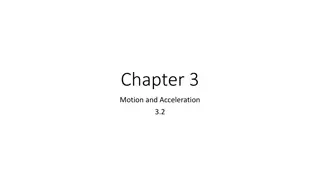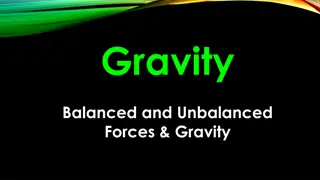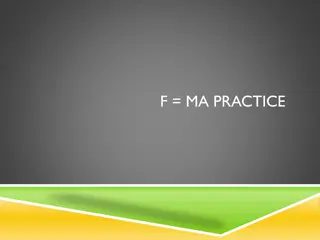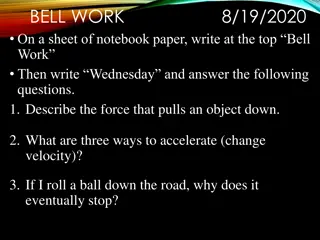Understanding Acceleration, Gravity, and Forces in Physics
Explore the concepts of acceleration, gravity, and forces in physics. Learn how acceleration is measured, understand the force of gravity and its impact on falling objects, and discover the relationship between force and mass. Dive into practical applications and the role of friction in motion.
Download Presentation

Please find below an Image/Link to download the presentation.
The content on the website is provided AS IS for your information and personal use only. It may not be sold, licensed, or shared on other websites without obtaining consent from the author. Download presentation by click this link. If you encounter any issues during the download, it is possible that the publisher has removed the file from their server.
E N D
Presentation Transcript
Acceleration Measure of the rate at which an object s velocity is increasing (or decreasing). Units: metres per second per second (m/s/s or m.s-2). Formula: acceleration = change in velocity change in time a = v/ t
Gravity Gravity is a force which makes a free falling object accelerate. On Earth the force of gravity makes at object accelerate at about 10 m.s-2. This means that the velocity of an object increases by 10ms-1every second it falls. It doesn t matter what the mass of an object is. It falls at the same rate. https://www.youtube.com/watch?v=_mCC- 68LyZM Feather and hammer on the moon: https://www.youtube.com/watch?v=wtsNOMTlS 7E
Felix Baumgartner Felix Baumgartner jumping from the edge of space: https://www.youtube.com/watch?v=dYw4meRW Gd4 An object falling in Earth s atmosphere will accelerate until an opposing force (air friction or drag) equals the force of gravity. The maximum speed of a falling object in the atmosphere is called terminal velocity: https://www.youtube.com/watch?v=p0IZsfzDS4s
Force and mass A force is a push or a pull (a twist is a combination of both). A force applied to an object in the absence of friction will make the object accelerate. The larger the force, the greater the acceleration. The larger the mass of the object, the smaller the acceleration. Formula: Force = mass x acceleration, F=ma https://www.youtube.com/watch?v=iwP4heWDh vw
Practical applications Small car vs Big car: https://www.youtube.com/watch?v=sxUx6qi0I_k https://www.youtube.com/watch?v=lTAUV1Yj4N E https://www.youtube.com/watch?v=GKe6WhFL mi0 The best two ways to increase acceleration of any object is to decrease mass and increase the force.
Friction Friction is a force that opposes motion. Friction converts kinetic energy into heat energy. Reducing friction increases both acceleration and also the maximum speed an object can travel on Earth. Remember: Friction is not a factor that needs to be considered with moving objects in space.
Applications of friction reduction Cycling: https://www.youtube.com/watch?v=- aUOzYAuL48 The worlds fastest Indian: https://www.youtube.com/watch?v=02Yy1vih IKs























